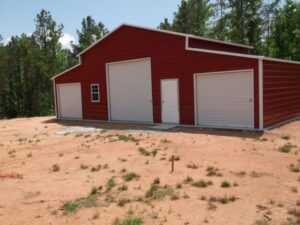As you begin to think about adding a new structure to your property, you’re almost certainly wondering how this will affect your homeowner’s insurance rates. It’s true that whenever you construct any new building, your costs will increase as you extend coverage to another valuable asset on your property. And if your new structure is worth more than 10% of the current insurance value of your home, or you are financing your building and your lender is requiring a separate policy on it, you may be facing a substantial change in your premium costs.
But did you know that specific facts about your new structure’s fabrication and how you’re planning to use it will determine how much more money your insurance company will charge you to protect it? Where you live matters, as well, but the material your structure is made of is the first point your insurance company will consider in calculating your rates.
The good news is building a steel structure like those we offer here at Newmart Builders can keep your current insurance rates from going up very much at all, especially compared to the potential increase associated with a new wood structure. Steel buildings tend to be looked at more favorably by insurance companies versus wood-framed buildings and even those made of certain types of masonry (especially if they have a traditional wood roof or floors). There are several reasons why choosing steel for your new structure is a smart money move.
Steel buildings present less risk to your insurance company
Construction type is a primary driver of insurance rates for buildings, and this has to do with how susceptible specific structures are to catastrophic fire damage. Basically, if a building is more likely to be totally destroyed by a fire in a relatively short period of time due to the “combustibility” of its construction, it will be more expensive to insure because of the higher likelihood that it will need to be replaced if disaster strikes. Completely replacing a building versus repairing and restoring it after a fire is much more costly for your insurance company, and you will inevitably be charged higher rates for constructing a more combustible structure like one made of wood.
Insurance companies utilize rating systems that consider historical information on buildings similar to yours in your local area to assess your risk. A common rating system used throughout the United States by insurance companies and agents to categorize structures is one developed by the Insurance Services Office, or ISO. This organization works with state insurance regulators to bring a measure of uniformity to the insurance industry, but some states and insurance companies rely on their own data for ratings. In any case, the ISO classifications are common and inform other proprietary rating systems, as well, to determine how fire resistant a given building is. Steel construction offers excellent fire resistance and presents less risk for this reason.
Steel buildings are noncombustible
That’s right – steel building are considered “noncombustible” in rating classifications. Six classes of structures exist according to ISO, and these are as follows (from most to least combustible):
1. Frame
These are usually buildings made from wood or other combustible materials. Even if exterior walls are made of a slow-burning or non-burning material like metal, if floors, roofs, or the underlying structure is made from wood, it’s usually considered frame construction.
2. Joisted Masonry
These can be brick or concrete block buildings with exterior walls that are somewhat fire-resistant, but that have combustible floors and/or roofs.
3. Noncombustible
Most steel buildings fall under the classification. With walls, support structures, and roofs made of metal that is either non-burning or extremely slow-burning, steel buildings are rarely destroyed by fire. Floor material must also be non-burning or slow-burning to qualify here, and many choose to build their steel building over a concrete pad or the ground itself, which are not combustible materials.
4. Masonry Noncombustible
Typically refers to masonry construction (brick, concrete block, etc.) that is over 4” thick and also has a noncombustible or slow-burning roof and floors.
5. Modified Fire-Resistive
This classification goes hand-in-hand with the least combustible type in #6 and refers to buildings made from masonry walls or assemblies that will perhaps burn in under 2 hours, but not in less than 1 hour.
6. Fire-Resistive
This most fireproof classification is for buildings that will not burn in less than 2 hours based on all materials being extremely noncombustible.
Since steel buildings beat out wood framed structures on combustibility every time, you’ll find a sometimes higher initial construction cost is easily overcome with insurance savings. In fact, an in-depth study performed by the Metal Building Manufacturer’s Association in 2015 found that across the US, the cost to insure a metal building is significantly lower than frame and joisted masonry buildings. And, a slightly higher initial construction cost can be recovered by the metal building owner in just a few years from the lower insurance cost.
Steel buildings stand strong against high winds and other damaging forces
As we’ve just discussed, insurance is primarily concerned with the combustibility of structures, but many other factors go into determining rates. The location of your property makes a difference to your insurance company in terms of whether damaging forces other than fire, like earthquakes, tornados, or hurricanes constitute a significant risk.
Steel buildings have an advantage over traditional wood-framed buildings in their ability to withstand hurricane force winds depending upon construction factors and shape. Historical data has shown that bent bow steel buildings especially, due to the rounded shape of the roofline, can face winds of up to 170 mph and sustain little to no damage. Following major storms in hurricane-prone zones like the coastal regions of the southeastern US, it’s often steel buildings that are still standing, while wood-framed buildings have been splintered apart by winds and driving rain.
It’s true that heavy rains are not a problem for steel buildings, either, as water damage is far less likely in a steel building. Wood can rot, but steel does not! Earthquakes also present less of a problem for steel structures than wood or even masonry buildings, which are made from materials that can crack or split apart. Steel can bend, of course, and if earthquakes are a concern where you live, working with a knowledgeable engineer on reinforcing certain frame members is recommended. That said, storm damage is a much more common problem than earthquakes in our home region here on the East Coast where many of Newmart Builders’ customers are insuring their buildings, so you likely don’t need to be concerned about seismic events.
Steel Buildings are easy to customize to maximize discounts
One of the best features of steel buildings is the fact that they are almost infinitely configurable and customizable to your exact specifications. This also makes these structures easier to upgrade in terms of safety and fire protection measures that may score you valuable discounts on your insurance policy. Often, adding a state of the art fire suppression system like sprinklers within your structure will significantly decrease insurance costs. Depending upon what you plan to keep stored in your new building, or if you’re planning to use the space as a workshop, you may want to seriously consider sprinklers. Though, even the presence of fire extinguishers and smoke detectors could help you save.
In the end, insurance is complicated. Your new building’s size and value, as well as the value of the contents that will be kept inside all play a role in determining your rates in addition to fire risk and the other factors we discussed. As you begin to plan your new steel building, it’s best to contact your insurance agent or company and see what the financial impact for your specific property and policy details will be. We’re also happy to help you navigate this process with expert advice and precise specifications on our materials and construction. Get in touch with us at Newmart Builders to learn more now.


